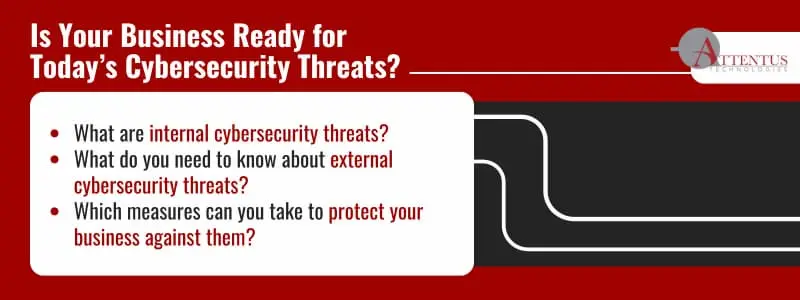Discover 10 measures you can take today to elevate your cybersecurity posture.

Does your business operate in a high-risk category, such as manufacturing or finance? If yes, you need to be aware of current cybersecurity trends and concerns.
Q1 2025 saw attacks increase by 47% compared to the same period last year, according to recent research. Companies providing financial services and those in industrial manufacturing experienced 1,747 and 1,554 weekly attacks, respectively.
It’s not a matter of if cybersecurity threats will occur, but when. And having the right kind of armor can make all the difference when you’re in a hacker’s crosshairs.
If you haven’t been breached yet, let’s keep it that way. Here’s what you need to know about the cybersecurity threats modern SMBs face, as well as how to prepare for them.
Types of Cybersecurity Threats
There are two types of cybersecurity threats: internal and external.
Internal cybersecurity threats originate from individuals within your company, and they may be malicious or unintentional.
Malicious insider threats typically originate from disgruntled employees, but cybercriminals may also plant someone in your organization to act in bad faith. That means you may unwittingly hire someone who intends, in part or in whole, to gain access to your system to leak information to their counterparts.
On the other hand, unintentional internal threats arise from:
- Poorly trained employees or those who fail to adhere to cybersecurity best practices
- The inadvertent exposure of your systems or their credentials to malicious actors
- Negligent handling of personal or company information through poor password management or something like it
You may also be familiar with phishing scams. These scams typically send a link to an email address, and can download malware onto your system, corrupt it, and transmit information back to a malicious actor when clicked. It can also hold your data hostage until you pay a ransom.
Recently, vishing (or “voice phishing”) scams have become one of the most common cyberattack methods with the rise of deep fakes and generative artificial intelligence (GenAI). Vishing simply means “voice phishing.”
It’s where threat actors leverage AI-generated deep fakes to clone your voice (or that of someone else in your company) to call employees and request information. This could include financial or customer information, or any other sensitive data.
Cybercriminals may also use third-party systems connected to yours as a backdoor. It was one of the most common cyberattack methods in 2024, accounting for over 35% of data breaches.
External threats, meanwhile, typically come from hackers who usually want access to compromised credentials such as login information, your email address, or your customer data.
Spoofing is another type of external threat. Here, a malicious actor creates a website that resembles yours to trick your customers into entering their private and personal information with the hope of collecting it or gaining access to your website.
Now that you’re aware of the two types of cybersecurity threats, it’s time to secure your systems. Let’s take a look at how to protect your business from these types of bad actors.
Business Cybersecurity Tips: How To Protect Against Cyber Threats
Cybersecurity starts with proactivity. Follow these 10 steps to improve yours:
#1. Only use secure Wi-Fi
Ensure there’s a secure Wi-Fi network at your office and that any off-site workers use one as well. You might consider a virtual private network (VPN) or a firewall.
#2. Practice password hygiene
You’ll want to require employees to use different, complex passwords across their various accounts. Password managers can help keep all your passwords in one place, but do so securely.
#3. Implement MFA
Adding multi-factor authentication (MFA) requires users to go through two login steps for essential systems. This makes sure that the person logging in is actually the person using the credentials.
#4. Leverage least privilege access
This is a critical cybersecurity risk management tool. Least privilege simply means granting each employee the minimum amount of access to your systems and data necessary to perform their job.
#5. Establish administrative controls
Administrative controls impose some type of monitoring on your employees to ensure they are only accessing information they need for their jobs, or at least to track when they access something that falls outside their scope.
#6. Keep software and systems updated
Technology vendors typically provide regular updates for products they still support. Ensure you are generally taking advantage of them when they are available to keep vulnerabilities at bay. This includes updates such as upgrading to Windows 11.
#7. Physical security
This can be as crucial as its digital counterpart. Lock down any locations where your information is stored, whether that’s a physical server, your office, or a company laptop.
#8. Vet third parties
If you’re hiring or using contractors, third-party workers, or vendors, vet them thoroughly to ensure you can trust them with any information you provide throughout your relationship.
#9. Raise cybersecurity awareness for employees
You need to provide employees with proper training about cybersecurity best practices. This could be specific to their jobs, or it could be teaching them how to use a password manager or about other password policies.
#10. Back up your data regularly (and have a response plan in place)
Even with the best preventative strategies, vulnerabilities can still slip through the cracks. You need to back up your data daily and test restores regularly to ensure you’ll still have access in the event of an attack. Have a comprehensive incident response plan complete with roles, responsibilities, and procedures, and be sure stakeholders are well-versed in how to execute it.
Let’s Leverage Cybersecurity Best Practices Together
Being proactive will prepare your organization for modern cybersecurity threats and keep your business resilient as attack methods evolve. If you need help with your cybersecurity strategy, you can always lean on experts.
At Attentus Technologies, one of our core values is to “be the answer” to our clients’ most pressing pain points. For over 20 years, we’ve been securing companies’ most valuable assets, earning the trust of business that stay with us for an average of 10 years. Top-notch cybersecurity has become a top priority for organizations that want to remain viable, and we are up to the task of ensuring yours is among the front-runners. We offer a full range of services, including network monitoring and data backup recovery, to protect your business.
Book a custom consultation to discover the benefits of leveraging our experience, expertise, and proprietary tools in mitigating cybersecurity threats.
